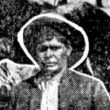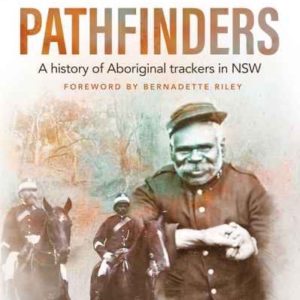Loading map...

Eric “Nugget” Mumbler was born at Kempsey in about 1916 to Harold Mumbler from the NSW south coast and Jane Drew of Pelican Island on the lower reaches of the Macleay River. Eric was living at Kempsey in September 1937 when he married Helen Donovan who also had ties to the south coast and Nambucca Heads. The couple raised a...
Learn More ►Broughton (also known as Toodwick, an anglicized version of his Aboriginal name) was an Aboriginal man from the lower Shoalhaven River in the vicinity of Coolangatta Mountain, or Cullunghutti as it was originally recorded. Born in the late 18th century, he worked as a young man for Charles Throsby of Liverpool and later as a...
Learn More ►The first police station at Milparinka was established in 1881, not long after the discovery of gold at Mount Poole and the subsequent opening of the Albert Goldfield. Thousands of miners flocked to the area and six policemen were posted at Milparinka to help control them. The stone police station shown in the accompanying photograph was constructed in 1885. Trackers...
Learn More ►Sam Hall (also known as Sam Hull) was born in Gowen County (between Gilgandra and Coonabarabran) in about 1845. Little is known about his life personally or professionally. It is likely he was a tracker in the Coonamble district although his name is yet to be found in official records. In later years, he lived on the Aboriginal reserve at...
Learn More ►Information about Monty Tickle’s origins are sketchy, but according to his death certificate he was born in about 1900 at Cloncurry, Queensland, to Friday Tickle and Topsy. It is not known when he came to NSW, but by 1921 he was the tracker at Orange in the central-west of NSW. In August of that year he investigated the illegal slaughter...
Learn More ►Henry Cleveland (also known as Harry) was born at Cleveland Bay near Townsville in about 1864. He knew little of his mother (she may have passed away when he was an infant), but probably lived for several years with his father, brother and sister. From a young age, Henry was adopted by a white family who took him to Adelaide. ...
Learn More ►Fred Briggs, a Gumbaynggirr man, was born at Farquarhar’s Creek near Nymboida in about 1866 to Thomas Briggs and Mary. His tracking prowess came to prominence when he found Edward Blaxland, his employer, in mountainous country on Marengo Station in the mid-1880s. Briggs was working as a stockman at the time. His first official employment as tracker was at Blicks...
Learn More ►Tommy Ryan, a noted Aboriginal stockman on the Upper Clarence between Grafton and Yulgilbar, was born in about 1860. It is likely that he was a Bundjalung speaker. He never worked as a tracker , but his run-ins with police meant that several trackers were sent after him. His story is significant because of his ability to repeatedly escape custody....
Learn More ►Alexander Ward (also known as Alexander King) was born at Bingebah Station on the western fringe of the Pilliga Scrub on 5 September 1887. He was the son of William King, an Aboriginal stockman born at Coonamble, and Jane Ward of Windsor in western Sydney. He married Stella Duncan of Coonamble at Burra Bee Dee Aboriginal Station in July 1916. ...
Learn More ►Jack "Smart Gui" Simpson was born along the Barwon River between Boorooma and Brewarrina in about 1880. Little is known about his parents, Jack Simpson Snr and Louisa Khan. Louisa is thought to have moved to Orange where she passed away. Jack told stories to his family of tracking Jimmy and Joe Governor in 1900 after the Breelong massacre near...
Learn More ►Jambie Lawson (also known as Jemmy, John or Jack) was born at Croagingalong in eastern Gippsland in about 1850 to Wothango and Loah. He was an important informant to ethnographer A.W. Howitt about Maap people who he said occupied the territory to the east of the Snowy River and as far as the Victorian coast. He may have attended the initiation...
Learn More ►This article is reproduced with the kind permission of the team at Koori History. See the original article written by John T. Patten at https://koorihistory.com/tracker-patten/ John James Patten, known as Jack Patten, was born in the Snowy Mountains of Victoria at Corryong in 1874. He was the eldest son of John Patten, a man for whom there is...
Learn More ►Working at Mount McDonald from June 1882 until the end of 1884, Tommy Pearce’s career is unusual in that it provides evidence that trackers sometime took a holiday. On Friday 27 April 1883, he passed through Carcoar “en route” to Dubbo for a “leave of absence”. The purpose of his trip or why the destination was Dubbo – perhaps he...
Learn More ►In 1862, police from the new amalgamated force were stationed at the new stone Court House and lock-up in Macquarie Street. A new station and lock-up were constructed in Brisbane Street in the early 1870s. Police barracks were constructed on Erskine Street in 1877 along with stables and quarters for the tracker. The police paddock was nearby at the northern...
Learn More ►The drought and depression of the 1890s may have forced some Aboriginal men to travel further afield than usual to obtain work and support. Mungo Park, born at Chatsworth on the Clarence River in 1870 to Ned Parker and an Aboriginal woman named Eliza, tracked for five years around Moree in the mid-1890s. His first assignment was at Meroe where...
Learn More ►Jack Redtank, the son of Ngiyampaa speakers Jimmy Keewong and Kitty Narrangie, was recognised as being one of the best trackers in NSW in the late 19th and early 20th centuries. His talents were brought to the attention of the authorities by David Harris, a European bushman who lived with Emily Keewong, Jack's sister. Jack's first job aged 16 was...
Learn More ►Pathfinders NSW — A History of NSW Aboriginal Trackers is a project by Dr Michael Bennett, Historian at NTSCORP. It is based on research conducted for a project funded by the Heritage Office of NSW (now incorporated within the NSW Office of Environment and Heritage). The website explores the history of Aboriginal trackers who worked for the current...
Learn More ►Billy Dargin was born on the Bogan River in about 1843. Nothing is known about his parents, but it was recorded at the time of his death in 1865 that he obtained his surname through working for Peter Dargin, a squatter who owned land in the Bathurst district and further west. Dargin is common Aboriginal surname from the Bogan River...
Learn More ►Tracker Tommy was based at Brewarrina in 1874 and throughout the year he undertook a variety of jobs. Unfortunately, no personal details about Tommy are known at this time [ref]An Aboriginal man known as McElligott’s Tommy was arrested on suspicion of having killed another Aboriginal man at a camp near Brewarrina in July 1876 (Maitland Mercury and Hunter River...
Learn More ►Norman Walford, the last officially employed tracker in NSW, retired from the NSW Police on 3 May 1973 after a career of 25 years. He is well-remembered in Walgett today – there is a walkway in his honour along the edge of the Namoi River – and his wife, Mrs Gladys Walford (nee Kennedy) lives in town. And many Aboriginal...
Learn More ►A distinguished tracker, John Watkins (nick-named Sir Watkin Wynne), was born about 1830, probably in Wiradjuri country between Bathurst and Forbes [ref]Sydney Morning Herald 9 August 1887: 8. I have inferred the broad area of Watkin’s birth place from the area where he is first mentioned in the historical record and the area to which he returned after retiring from...
Learn More ►James Nerang, or Jimmy as he was often known, worked as a tracker in the central-west of NSW around the turn of the 20th century. He took a prominent part in tracking Jimmy and Joe Governor after the massacre at Breelong in 1900. He was stationed at Dubbo in January 1902 when he gave evidence identifying Charles Ryan, an Aboriginal...
Learn More ►Harry Doolan, a Gamilaraay man, was born at Pilliga in 1855 to Bob Doolan and Tincan [ref]DC of Harry Doolan 1917/012607.[/ref]. He began tracking at Wee Waa in April 1891 where he remained for the next two years. His next tracking assignment was at Baradine for the first three months of 1898. He was also the tracker at Cumnock in...
Learn More ►Molong Police Station The only recorded tracker at Molong was Tommy who worked from 1883 to 1886. Nothing more about his life is currently known and trackers were not stationed at Molong after he left. A 20th century tracker with a link to Molong was Robert Henry Robinson who worked at Coonamble and Dubbo. His grandmother was Kitty Hanley, who,...
Learn More ►There were over 200 NSW police stations that employed Aboriginal trackers between 1862 and 1973. Many were concentrated in the central-west and north-west of the state, the agricultural and pastoral heartland of NSW. This is because one of the main jobs of trackers was to pursue sheep, cattle and horse thieves. Trackers sometimes lived in small huts out the back...
Learn More ►A contemporary of Alex Riley, Frank Williams was a tracker who also received numerous accolades throughout his career. Williams was born in the country between Gundabooka and Toorale in the 1870s to Edward Williams and an Aboriginal woman named Fanny Hippi. He is associated with the Ngemba speaking peoples south of Bourke. After working as a labourer, he was appointed...
Learn More ►
 This website explores the history of Aboriginal trackers in NSW from 1862 when the current NSW Police Force was established through to 1973 when the last tracker, Norman Walford, retired. You can read about the lives of individual trackers and some of the incredible tracking feats they...
This website explores the history of Aboriginal trackers in NSW from 1862 when the current NSW Police Force was established through to 1973 when the last tracker, Norman Walford, retired. You can read about the lives of individual trackers and some of the incredible tracking feats they...

There were over 200 NSW police stations that employed Aboriginal trackers between 1862 and 1973. Many were concentrated in the central-west and north-west of the state, the agricultural and pastoral heartland of NSW. This is because one of the main jobs of trackers was to pursue sheep, cattle and horse thieves. Trackers sometimes lived in small huts out the back...
Learn More ►
Pathfinders book Pathfinders, A history of Aboriginal trackers in NSW, written by Dr Michael Bennett and published by NewSouth, is now available from all good bookstores. Click on the link below to order your copy. https://www.abbeys.com.au/book/pathfinders-a-history-of-aboriginal-trackers-in-nsw.do Early History Since the beginning of the colony, government agencies, explorers, surveyors and members of the general public called upon the tracking...
Learn More ►